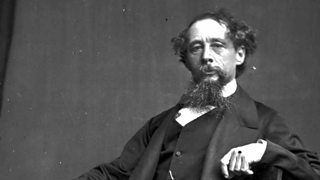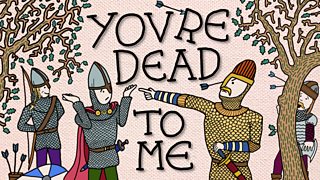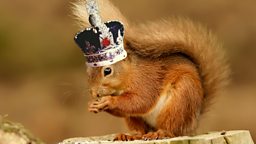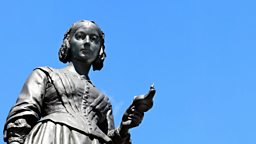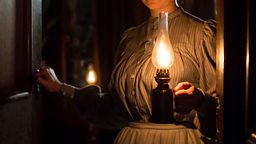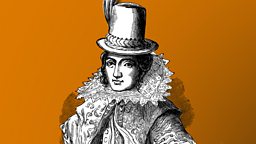Proper Charlie: 12 things you didn't know about Charles Dickens
With everyone cooped up in the house at the moment, Horrible Histories and You’re Dead To Me maestro Greg Jenner has decided to put together some snappy facts from the past in his new podcast Homeschool History. This week he's tackling the gargantuan literary figure and one of the most famous writers ever to live: Charles Dickens. But what unusual Dickens tidbits did he uncover?
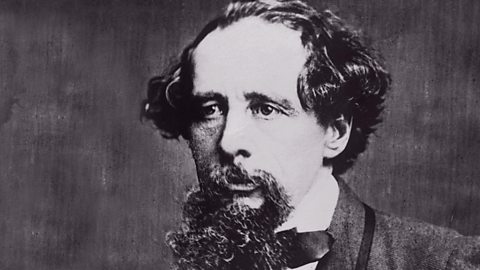
Who was Charles Dickens?
Greg Jenner talks about Charles Dickens' tough upbringing.
1. The Dickens family crest was not the Dickens family crest
Charles was born in 1812, but his family were not in any way posh. But they really, really wanted to be posh. In fact, his dad was so desperate to be seen as slightly upper class that he “borrowed” the crest of a more well-to-do family to use for himself.
2. His sister was supposed to be the famous one
Charles came from a large family, the second of eight children. As we have learned, the family were desperate to increase their poshness, but young Charlie was not seen as the one to do this. Instead, his sister Fanny was sent to study at the fancy Royal Academy of Music in London. Charles was hurt that he wasn’t sent anywhere to do anything.
3. His whole family went to jail
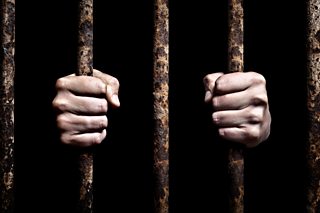
David Copperfield was originally going to be his autobiography, but Charles was so ashamed that he made it into a story instead.
The family’s attempts at getting posher ended in disaster. Charles’s dad spent far more money than he had and ended up in prison for not paying his debts. As was common at the time, the whole family went to live with him in jail until his debts could be paid off. Only poor old Charles, aged 12, kept his freedom… so he could work in a pretty grim factory pasting labels on to bottles.
4. He was too ashamed to write his life story
Tales from his sad time in the factory were later used in the Dickens novel David Copperfield. This book was originally going to be his autobiography, but Charles was so ashamed of his family going to prison and his label-sticking days, that he made it into a story instead. But there’s a hidden clue in the title. David Copperfield’s initials, D.C. are the reverse of the author’s: C.D.
5. He was a bit of a prankster
Though he’s now viewed as a literary heavyweight, Old Charlie D was known to let his hair down now and again. On one occasion, while trying to impress his future wife Catherine, he leapt through the window of her family home while dressed as a sailor and performed a vigorous hornpipe dance before leaping out again. He then entered the house through the front door, dressed normally, and never mentioned it. Top bantz!
6. If you knew him you might end up in a book
Though Dickens displayed plenty of imagination and flights of fancy when he was writing his novels, he did use incidents, and people, from his own life as well. He knew someone at the label factory called Bob Fagin and later used the name in Oliver Twist. Sam Weller in Pickwick Papers was named after his childhood nurse Mary Weller. And Bob Cratchit, the underpaid clerk in A Christmas Carol, earned the same wage that Dickens did when he worked as a lowly clerk in a lawyer’s office.
7. You wouldn’t find the name “Charles Dickens” on his early books

Dickens didn’t even want to be a writer, he had ambitions to be an actor, but he caught a cold on the day of his acting audition and missed his big break. So instead, he became a reporter in Parliament. It’s thought that Charles was determined to make his stories stand out in the newspaper, so he wrote them using the unusual pen-name of “Boz”, a family nickname. And it was this name that appeared on the cover when his first novels were published.
8. He was binge-worthy before bingeing was a thing
Most of Dickens’s work wasn’t published in book form at first, but appeared in instalments in magazines. Often the style of the story would change from episode to episode as the story developed. But Dickens made sure his readers were gripped by giving each instalment an exciting, cliffhanger ending. Fans would get so wrapped up in the story that American readers would line up at the docks, waiting for ships from England, so they could ask the passengers what happened next in a particular tale. Spoiler alert!
9. He was a very modern celebrity
Like the famous people of today, Dickens had to deal with quite a bit of personal scandal in his life. While he was still married, he started having an affair with an actress called Ellen Ternan. A piece of jewellery he was planning to send to his new girlfriend was accidentally delivered to his wife instead. Totes, as they say, awks. Dickens’s behaviour towards his wife damaged his “personal brand” in the eyes of his fans.
10. He was like an early rock star
Despite the setbacks in his personal life, Dickens was hugely popular, especially in America where he would frequently take to the road and go on tour. Fans of Charles would sleep on mattresses outside the venues where he was appearing to make sure they got a seat. Dickens made a massive amount of money from these tours, but the energy he would put into each of these gigs would leave him exhausted.
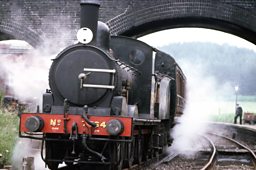
11. He had a fear of trains
Dickens was involved in a tragic accident when the train he was travelling on plunged off a bridge.
In 1865, Dickens was involved in a tragic accident when the train he was travelling on plunged off a bridge. Charles managed to escape serious injury and helped the other passengers, comforting the dying before rescuers arrived. He also went back into the train to grab his unfinished manuscript for Our Mutual Friend which he’d left in the carriage. He avoided travelling in trains for the rest of his life. He also avoided appearing at the inquest investigating the crash, as he’d been travelling with his mistress at the time.
12. He left the ultimate cliffhanger
Dickens died, at the age of 58, in 1870. At the time he had been working on a whodunnit novel, The Mystery of Edwin Drood, which soon became a mystery in itself. Only half the book had been written and Dickens left no clue as to how the novel should conclude. Many writers and Dickens fans have offered theories on how the story should end.
More from Radio 4
-
![]()
Homeschool History: Charles Dickens
Greg Jenner gives the lowdown on the Victorian author.
-
![]()
In Our Time: Charles Dickens
The achievements and legacy of the 19th century literary giant Charles Dickens.
-
![]()
You're Dead To Me
Greg Jenner's other fascinating history podcast.
-
![]()
Homeschool History Lesson: The Space Race
Facts about the battle for the stars.

